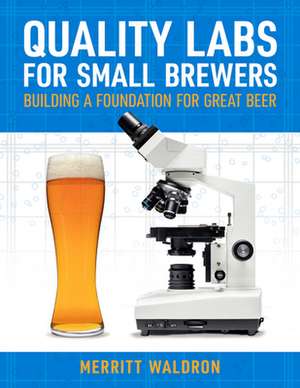Quality Labs for Small Brewers: Building a Foundation for Great Beer
Autor Merritt Waldronen Paperback – 6 iun 2020
Preț: 449.82 lei
Preț vechi: 488.93 lei
-8% Nou
86.07€ • 93.87$ • 72.58£
Cartea se retipărește
Specificații
ISBN-10: 1938469631
Pagini: 250
Dimensiuni: 216 x 279 x 18 mm
Greutate: 0.68 kg
Editura: TRADE SELECT
Notă biografică
Cuprins
Table of Contents
Introduction
About the book
What I assume about the reader
What's this Quality Control Thing About Anyway?
Quality Control
Quality Assurance
Quality System
The Structure
Part I ¿ Building a Solid Foundation
Chapter 1 ¿ Food Safety Modernization Act
Introduction
Food Safety Terms
What FSMA Means for Craft Brewers
What if My Facility is a Brewpub?
How Do I comply?
Chapter 2 - Good Manufacturing Practices
What are Good Manufacturing Practices?
GMPs vs. SSOPs
Familiarize Ourselves with GMP Requirements
Personnel
Plants and Grounds
Sanitary Operations
Sanitary Facilities and Controls
Equipment and Utensils
Warehousing and Distribution
Holding and Distribution of Human Food By-Products
Defect Action Limits
Culture of Food Safety and Quality First
Writing a GMP Manual
Next Steps, Auditing
Chapter 3 ¿ Food Safety Program
Common Food Safety Hazards Around the Brewery
Physical Hazards
Chemical Hazards
Biological Hazards
Control Points and General Control Methods
Assemble Your GMP/Food Safety Team
Put it in Writing
Monitoring Principles
Critical Control Limits
Recall Planning
General notes About Your Recall
Recall Plan in Seven Steps
Things to Add to Your Food Safety Program
Chapter 4 ¿ Standard Operating Procedures (SOPs)
Writing an SOP
Supporting Components
Using a Template
Implementation, Training, and Upkeep
Chapter 5 - Cleaning and Sanitation
Cleaning
Sanitation
Application Variables
Part II ¿ Starting Your Quality Program
Chapter 6 ¿ Starting Your Quality Program
Planning Your Program
Safety
Identifying Quality Control Points
Sampling Plan
Pulling it all Together
Chapter 7 - Writing a Quality Manual
Quality Policy
Quality Governance and Management
Standard Procedures
Specifications of Finished Products
Consumer and In-house Complaints
Corrective Action Plan
Master Sanitation Schedule
Good Laboratory Practices
Calibration Plan
Conclusion
Part III - Measurement
Chapter 8 - Weight, Volume, Concentration, and Dilution Equations
Basic Volume Calculations
Area
Volume
Volume and Temperature Relationship
Volume, Density, and Weight
Problem Solving by Dimensional Analysis and Unit Conversions
Making a Standard Solution
Serial Dilution
Mixing Equation
Scaling
Chapter 9 ¿ Density
Specific Gravity and Plato
Where to measure
Sampling Plan
Troubleshooting
Chapter 10 ¿ Temperature
Temperature Scales
How to Measure
Where to Measure
Sampling Plan
Troubleshooting
Chapter 11 ¿ pH
pH: A Closer Look
Hydrogen Ion Sources
Buffers
How to Measure
Where to Measure
Sampling Plan
Troubleshooting
Chapter 12 ¿ Yeast
Yeast Management
How to Measure
Microscope Basics
Getting to Know Your Hemocytometer
Viability & Methylene Blue
Limitations and Counting Rules
Serial Dilution
ASBC Yeast-3
Craft Brewers Quick Method
Pitch Rate
Where to Measure
Sampling Plan
Troubleshooting
Chapter 13 ¿ Sensory
What is Sensory Analysis
Sensory Program
What We Measure
Practice
Developing Brand Recognition ¿ True to Brand
Getting Formal
Data Collection Forms
Data Collection
Flavor Standards/Off-Flavors
Goal Setting
Conclusion
Chapter 14 ¿ Microbiology
Concerns of Brewers
Ingredients
Environment
Sterilization
Aseptic Technique
Traditional Plating Culture
Choosing the Right Media
Building Confidence in Your Results
Plating Methods
I Have Growth on My Plates! What's Next?
Yeast Identification
Bacteria Identification
Document Results
Next Steps
Advanced Methods
Bringing PCR Into Your Brewery
Chapter 15 - Packaging Quality
Receiving Packaging Materials
Fill Height
Closures
Can Seam Measurements
How to Measure Can Seams
Sampling Plan
Bottle Seals
Secondary Tests
Date Coding
Container Lot Tracking
Labeling
Chapter 16 - Carbon Dioxide
Henery's Law
Units
Where it is Measured
How is it Measured
Where to Measure
Troubleshooting
Chapter 17 - Dissolved Oxygen
Where to Measure
Sampling Plan
Troubleshooting
Chapter 18 - Alcohol
How to Measure
Where to Measure
Sampling Plan
Troubleshooting
Chapter 19 ¿ Titrations
Preparing for a Titration
Titration of a Strong Acid with a Strong Base
How to Measure
Where to Measure
Troubleshooting
What is it used for?
Chapter 20 ¿ Spectrophotometry
Principles of Measurement
How to Measure
Where to Measure
Chapter 21 ¿ Turbidity
Units
How to Measure
Where to Measure
Part IV ¿ Getting To Work
What Every Brewery Should Measure and Document
Chapter 22 ¿ Setting Up Your Brewery Lab
One Goal, Different Approaches
The Retro Fit Approach
The Collector Approach
The Build Out Approach
Budgeting
Lab Safety
Chapter 23 ¿ Introduction to Analysis
Variables
Plan-Do-Study-Act Cycle
Conclusion
Chapter 24 ¿ Data Collection
Accuracy and Precision
Sources of Error
Mean, Normal Distribution, and Standard Deviation
Normal Distribution of Data
Chapter 25 ¿ Data Organization and Analysis
Developing Brew Logs
Analyze Your Data
Getting Data on the Spreadsheet
Charting Best Practices
Moving Range Chart
Chapter 26 ¿ Plan-Do-Study-Act Cycle
PDSA Example Case Study
Setting Product Specifications
Chapter 27 - Continuous Improvement
Where do I Start?
Continuous Improvement in Your Future
Chapter 28 ¿ Conclusion
Final Words of Advice
Appendix A ¿ Basic Good Manufacturing Process Example
Appendix B ¿ GMP Audit Checklists
Appendix C ¿ Food Safety Plan Templates
Appendix D ¿ Recall Planning and Procedure
Appendix E ¿ How to Write an SOP
Appendix F ¿ SOP Example ¿ Equalibriated Package Dissolved Oxygen Samples
Appendix G ¿ How to Use a Hydrometer
Appendix H ¿ ASBC pH Fishbone XXb
Appendix I ¿ SOP Forward Pipetting Technique
Appendix J - SOP_Forward_Pipetting_Technique
